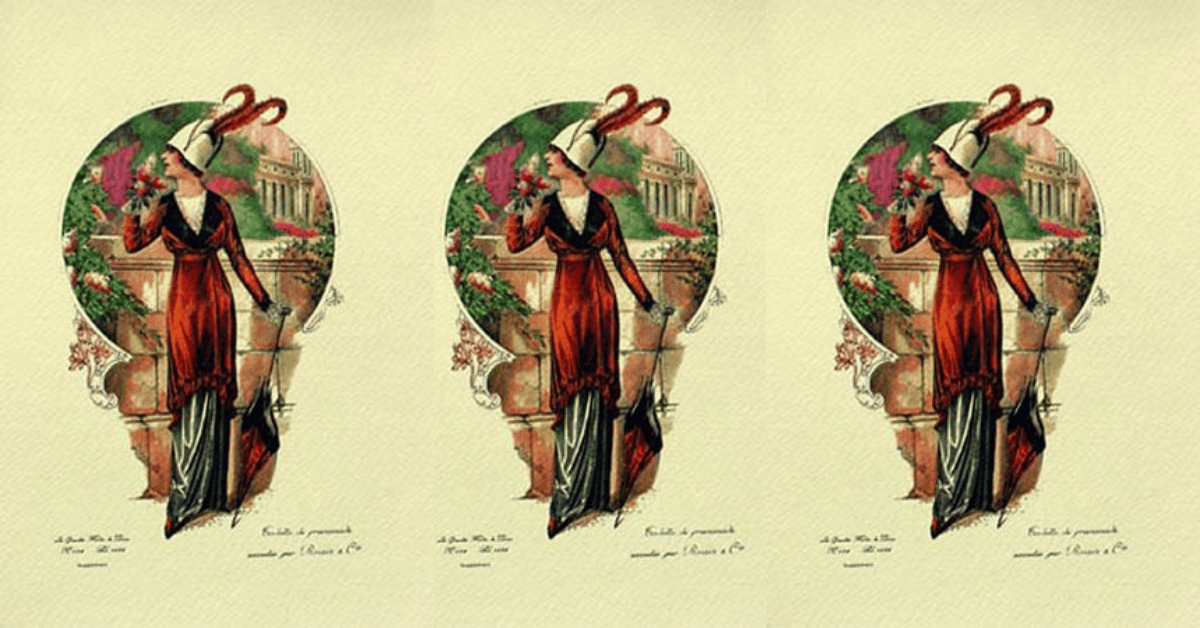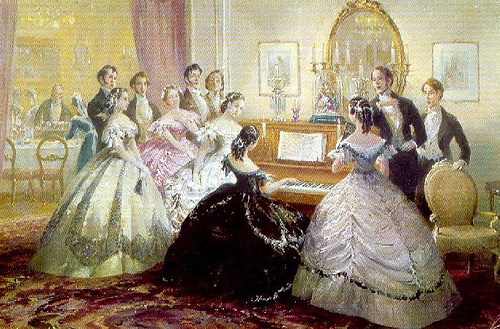By Pauline Weston Thomas for Fashion-Era.com
Georgian Era
The period 1800-1837 is part of the Georgian era. George III was insane after 1811, but lived on until 1820. His son the Prince Regent, George, acted as Regent for nine years of the King's madness, then reigned 1820-1830.
Because of the influence of the Georgian Prince Regent, this is early part of the C19th is known as The Regency Period, and in costume history terms the Regency fashion era. Accessories such as those shown on this page were an essential part of the fashion of the Regency period.
Shawls
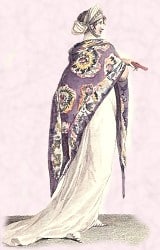
Throughout the Regency Era the lightweight robes needed other garments or accessories to make the wearer warmer. Tulle shawls which were delicate and light particularly suited fine evening dresses. White muslin net shawls embroidered with tambour work were made in Essex where a thriving cottage industry was set up by a Flemish refugee. Not far away Norwich produced silk warp and wool weft twill Norwich shawls which were almost Chinese in design.
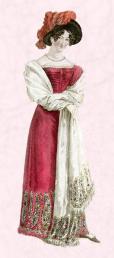
Kashmir Shawls
The warmest Regency era shawls were primarily made from cashmere wool.
Genuine Kashmir shawls of the most beautiful quality made from very fine wool with woven and embroidered patterns were considered one of the most useful and attractive accessories. The draped shawls emphasised the classical effects that women in Regency England strived for. Taste was everything to the gentry of the Regency era. Other stoles and long slender scarves were also used, but the Kashmir shawl was prized.
An example of an oriental influenced shawl in rich golden hues is shown in the header painting of Madame Recamier. Madame Recamier was a famous French beauty of her day - celebrity is nothing new!
Changing tastes in fashion through the Regency period meant the fashionable way of wearing Kashmir shawls changed with the years.
Eventually the shawls were copied by manufacturers in Britain and especially by the towns of Paisley and Norwich. Paisley made reversible shawls. Firstly they were woven, but later to cut costs and beat competition Norwich started to print the shawls.
By the Edwardian Era even cheaper printed paisley shawls bought for shillings were worn solely by the lower classes. The once sought after items had become so watered down and universally changed from a true Kashmir shawl that the upper class ladies rejected them.
You are reading an original 1800s Fashion History Accessories article by Pauline Weston Thomas at www.fashion-era.com ©
Hats
Caps and Turbans - Hats Early 1800s
The Regency era had an endless supply of fascinating headwear that became more and more outrageous as the era moved on. When the C19th began a wide range of hats from small caps to enormous ribbon festooned bonnets. These plus turbans, feather trimmed satin jockey hats and poke bonnets were all part of Regency gentlewoman's wardrobe. At night exotic turbans were usually seen. The white satin mameluke turban was trimmed with an ostrich feather and worn early on in 1804. An example is shown to the right below.
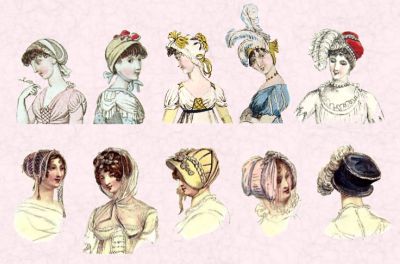
In 1800 caps were worn mostly in the day by older ladies, then in the 1820s young people generally wore them in the day. Some references hint that the morning cap of white cotton covered up paper tied ringlets for release later in the afternoon.

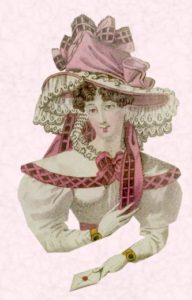
Poke bonnets like these above right and circa 1816/17 had a soft crown and could be called a capote. Firmer crowned bonnets trimmed with ribbons, feathers, frills and sometimes flowers shown left soon got larger. The variety and range of trimmings can be fascinating and is always a source of joy when studying Regency era fashion plates.
At the height of the Regency era and beyond 1815 the bonnet size increased until the crown was very big and culminated in the Leghorn style shown right. The name comes from the leghorn straw used. Fabrics such as taffeta silk were ruched and pleated to make flowerpot style hats with wide deep brims.
Jewellery
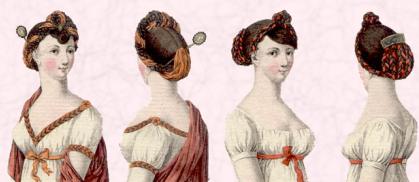
Throughout the late Georgian fashion era ladies wore a limited amount of jewellery. They liked dainty necklaces and other pieces including combs of jewelled hair ornaments all modelled on original Greek items. Braided hair was dressed with combs as show in the illustration above of Grecian influenced hairstyles. these date at 1804.
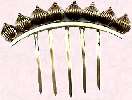
The women kept hair shorter and cleaner, but enhanced with false ringlets, an ideal style to show off earrings.
After the coronation of Emperor Napoleon and Empress Josephine when the splendid, reset, French royal family jewels were worn, matching jewel sets called Parures once again gained popularity.
As the Regency progressed hairstyle became much more elaborate and so did the hair jewellery.
Reticule Handbags
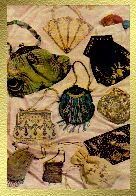
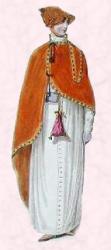
The reticule bag was a new accessory in the late 1790s because before then, women had carried their pockets about their waist when their gowns had been large enough to hide them. The advent of slender columns of muslin meant that pocket purses could be seen beneath dresses and so the reticule came into fashion.
Reticules were pretty small decorative purse like bags, similar to an evening bag of today and they held a lady's belongings.
Some had steel hoops which gave a concertina like framed effect. Still others might be steel mesh trimmed with Pailettes and steel fringe beading. Others might be circular with ribbon drawstrings and feather trimmed.
Drawstring reticule styles have always been popular since they are easy to self craft. C19th magazines intended for gentlewomen who could read, supplied plenty of how-to ideas for ladies to pass away their days making needlecraft items for personal use.
The handbag as we know it today was established in the Regency era. By the 1820s the reticules had become proper handbags either soft drawn up leather or rigid and buckled hard leathers or decorative materials.
Dainty Parasols
Folding small fans, and shot silk or taffeta parasols with ivory handles were used as decorative, rather than functional accessories in the early C19th and through the Regency. By the Victorian era parasols were often larger as they were by then more utilitarian and designed to protect the face from sunburn since a suntan was a common vulgar look for a real gentle lady.
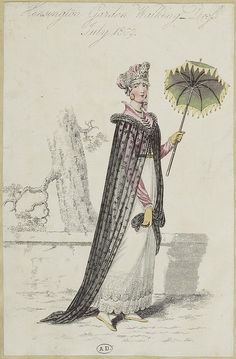
The Muff and Tippet of 1804
The Muff

Fur muffs were a strong fashion accessory of 1800, but not of the true Regency period. By 1811, the massive huge fur, feather or shirred silk muffs which began the C19th disappeared totally ending the fashion with smaller rounder muffs. But by the nature of the muff there is always some volume.
The Tippet
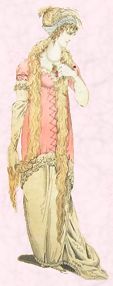
The tippet was a long slender boa fashion accessory used to wrap the neck area. It was worn at various times, by all classes, at some time in the 19th century. By the end of the century it took on a 'gaiety' girl effect, especially when made from inferior materials.
It was a fancy version of the scarf and could be made of swansdown or fur. Worn initially by the gentlewoman of c1800 it was eventually favoured by poorer woman of the 1890s.
Gloves
By night ladies wore the longest of gloves reaching right to the tiny sleeves. By day short gloves that matched dresses were best.
You are reading an original 1800s Fashion History Accessories article by Pauline Weston Thomas at www.fashion-era.com ©
The Cloak or Mantles or Mantelets
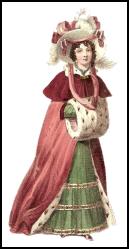
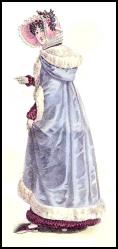
Cloaks and mantles or mantelets were three quarter length or full length. Winter cloaks like this red cloak mantle of 1827 left were fur lined.
Witzchoura Mantle
About 1808 the Witzchoura mantle a fashion from Poland was a fur trimmed three quarter length mantle with wide open sleeves. This is true Regency fashion.
Below - Witzchoura Mantle from the later Romantic Era showing actual lines and a fashion plate of 1835 showing a brown mantle. The sleeves show mantle development in line with the huge sleeves of the 1830s Romantic era. The look has more relationship with later Victorian fashions.
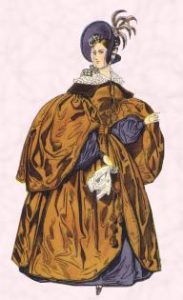
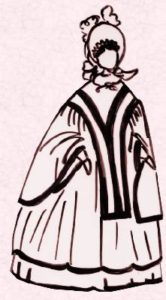
You are reading an original 1800s Fashion History Accessories article by Pauline Weston Thomas at www.fashion-era.com ©
For more information on mantles see my section here :-
Costume History - Cloaks, Mantelets, Pelisses, Redingotes, Paletots
Footwear
The flat or low heeled pump that replaced 18th century heeled shoes was an accessory fashion for forty years in Great Britain. throughout the Regency era the shoe was often trimmed with a bow or rosebud. These shoes were made of soft kid, cloth or silk and were very flimsy, so wore out easily.
They were basically little more than ballet slippers. The flat sandal sometimes had ribbon ties that were crossed over the leg reaching to the calves. They were almost too fragile to wear and were mainly worn in the evenings or indoors. The half boot was worn for outdoors.
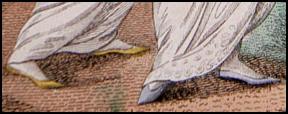
Then about 1810 as the true Regency era began, the flat soled boot was worn by fashionable women for general wear. These were attractively made of coloured leather or leather and fabric or the same fabric as pelisses.
In a short time boots became so usual that even bride's boots and dancing boots were made. Proper walking for gentle ladies other than in landscaped gardens was unknown. Pumps were not made for anything other than a tiled promenade.
1800s Style Contribution to Fashion Accessories of Today
Several of the accessory items on this Regency page are still some of most used accessories today. Many have come in and out of fashion as new styles arise. Yet, some accessories are enduring for their utility whilst managing to combine daintiness and prettiness within the item.
Pashmina shawls plain and patterned have become a fashion classic. Hair ornaments - barrettes and decorated combs continue to be useful. Short and long tippets regularly appear each winter as that exotic cover up that both keeps the wearer warm and nods to fashion.
Some fashions like the umbrella became totally utilitarian for twenty years contracting and shortening until they are frequently no more than 6 inches in length. But now they are being hailed as fashion accessory again and pagoda style versions also very popular in the 60s have once again re-emerged.
Flat ballet shoes were all the modern rage 200 years later in the noughties, but most enduring of all is the reticule bag accessory. The small dainty evening bag has never really gone out of fashion. It is always a must-have accessory for any special occasion and the finishing touch.
Fascination with the reticule has been intense in the past 5 years with the minaudière reaching a new generation. Re-enactors will always find these simple accessories available in fashion stores today, making dressing up in the world of Regency England or Jane Austen so much easier.
This original article webpage has been about 1800s Fashion History Accessories by Pauline Weston Thomas at www.fashion-era.com ©
